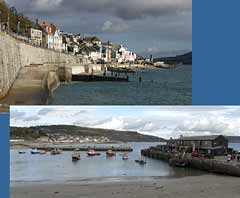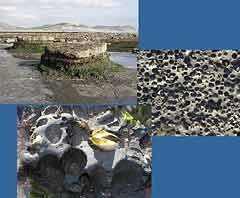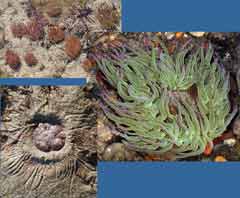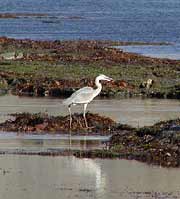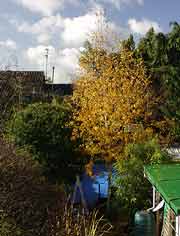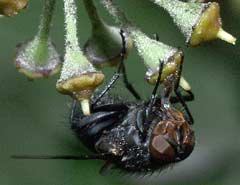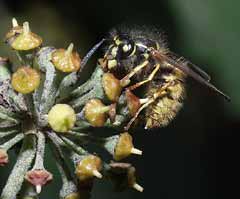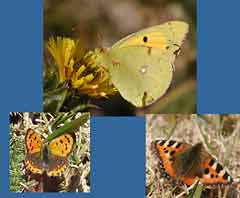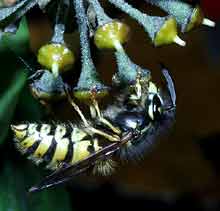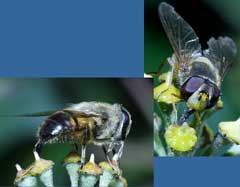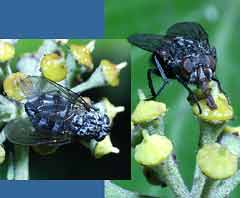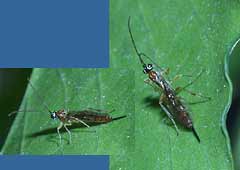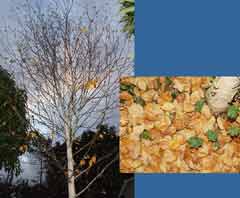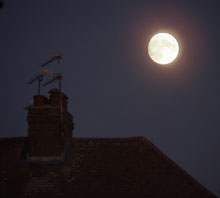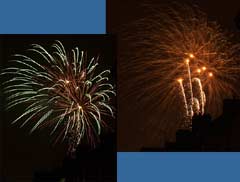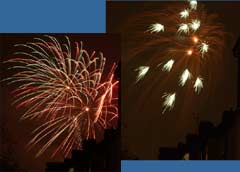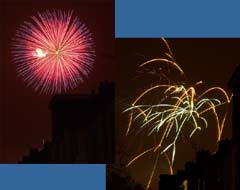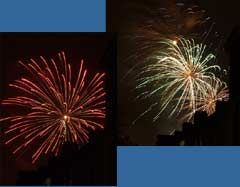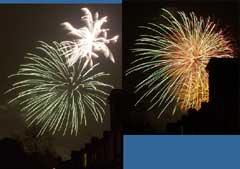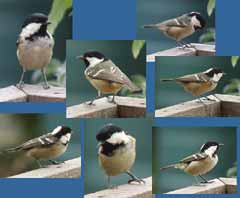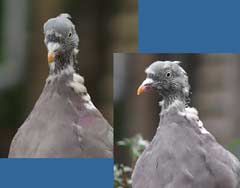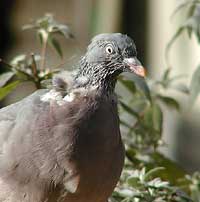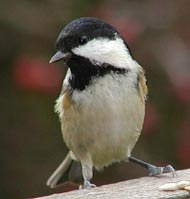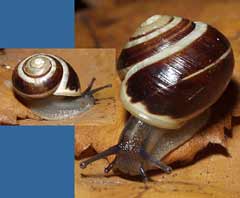Go to last entry.....................................Go to previous entry
5 November - It seems like a very long time since my last entry. I've been having a bit of a struggle with the CFS these last few weeks and it has been very difficult to get much done. The weather has now turned more Autumnal with more weather fronts moving in from the Atlantic, bringing us sunshine and showers but also spells of heavy rain and more wind.
I didn't go fossil hunting but spent time wandering over the foreshore at low tide. The weather stayed dry for most of our time there and the sea stayed flat calm - no chance of the sort of storm pictures I took down in Cornwall this time last year! Click on the images to see larger versions The area is referred to as the Jurassic Coast and most of the fossil hunting goes on where there have been rock falls from the extremely crumbly cliffs. Down on the foreshore there are layers of harder rock with softer shale layers. In some parts these softer, grey layers have been burrowed into by large numbers of American Piddock bi-valves. In the top image the columns are just over 2ft tall. In contrast, the cliffs in the background include the highest point on the South Coast. If you look at the larger version of the image, the pointed portion of cliff at the extreme right is known as the Golden Cap, and is 627 ft high.
Many of them seem to be secured in old Piddock burrows. At low tide, when some of these areas are uncovered the anemones gradually retract their tentacles to conserve water, leaving a pattern of tracks in the sand as they do so.
This is one of just a few bird photographs taken during the trip. I took the picture just after the heron had caught a fish. It seemed to be a regular visitor to the same area of rocks and I saw it every time I went to that end of the shore.
Back home in the garden Autumn has really taken hold of the Birch tree now, and its golden coloured leaves are being shed quickly. The Hawthorn is already nearly bare. A few weeks ago, the people living beyond the back of our garden (to the left) reduced the height of the conifers at the end of their property. The blue thing below the Birch is a cover over the area I have been working on. Yesterday I dug a trench across that area, installed a length of piping, and threaded through the video leads needed for the birdbox webcam.
In this picture you can see how the fly's fleshy proboscis is unfolded to mop up the liquids on the flower surface.
All of the pictures in this entry, with the exception of the Heron, were taken with my new camera. I'm still working out how to get the best results with it, especially for close-up work, but I've been pleased with it so far.
I nearly forgot one more group of Lyme Regis pictures. The south facing steep grassy areas by the seafront were sheltered from cold breezes and there was butterfly activity to be seen throughout the first part of the week.
At least three brightly coloured Clouded Yellows (top image) were seen on several days, darting about between flowers. This one had somewhat ragged wings, but was the only one I could get close to. The lower images show a Small Tortoiseshell (right) and a diminutive Small Copper which must have measured an inch across at the most. I only saw each of these once and couldn't get close enough to get good images.
Click on the images to see larger versions
6 November - A remarkable Autumn continued with a warm (18C) and almost cloudless day (It seems that Heathrow airport had its warmest November day on record - 19C). Within a day of taking the garden picture (see above) the Birch tree has shed a lot more of its leaves and we can now see through it, and they continued to fall as I took the photographs.
The Ivy was a centre of a lot of insect activity throughout the day. There were more wasps like this one about than over the last few days.
Visitors included lots of hoverflies of various species, including these two. The two images are not the same scale, and the one on the left is the biggest. Unfortunately these was the only shots I was able to get so I can't identify them using my guides.
There were lots of flies about with the largest being ones like this one. Again, identification is a problem, but its wing venation matches the Insect Guide illustration of Polietes lardaria. It has a distinct blue metallic sheen and darker strips over its thorax and abdomen.
Finally, just as the sun passed behind the tree line to cast a shadow over the lower parts of the Ivy, this little Ichneumon fly (probably) perched briefly on a leaf, cleaned its antennae and then flew off again.
It always surprises me how quickly the evenings get darker (even taking into account the change from BST to GMT). I have just adjusted the timer on the outside lights for the second time since we got back from Lyme Regis. On the bird front things are relatively quiet at the moment. Our flock of Sparrows goes through periods of very noisy choir practices, punctuated by squabbles. Today I saw several males displaying in the Hawthorn. Before we went away I described a Sparrowhawk attack in which a Collared Dove was caught by then escaped. During the last two days there have been visits by a Dove which has obviously been attacked by something. It isn't hindered by the damage around its neck area - I wonder if it is the one involved in that attack. The hawk was here again yesterday but left without catching anything. I only see a blackbird occasionally at present, but we seem to have a pair of Blue Tits around in the garden most of the time. Hopefully they will hang around to use the box next Spring. A Coal Tit appeared again this morning to take Sunflower kernels from the Bird table. A couple of Wood Pigeons continue to be regulars at the feeder. Last of all, and a note that should be put into the pond diary - when I went down to my shed at about 10pm last night I nearly trod on a newt that must have been out hunting. It appeared to be quite sluggish, but in the minute or two it took to collect my camera it had disappeared so I couldn't get a picture.
Today it has been overcast and quite cold with Easterly winds, and Sod's Law has been confirmed again today as the clear skies of the last few days have been replaced by the complete cloud cover just in time for the eclipse of the moon tonight.
I took this picture (facing East) under clear skies last night to try out the new camera, just in case I decided to stay up for the eclipse -However, it looks as thought I will be able to get to bed early tonight!
At least the cloud base was high enough not to spoil the fireworks displays going on this evening, and I was able to take some photographs of that from our garden.
Tonight the Easterly wind meant that the fireworks drifted West enough for them to be visible from the much darker back garden.
Click on the images to see larger versions At 1am, after hearing on the radio that the moon was visible in London, I went out side to see only cloud! I nearly forgot - This morning while I was replenishing the bird table A Sparrowhawk swooped into the garden circled the Hawthorn and then flew down the garden and perched on a tree branch next to the Ivy. I had a great view of the blue-grey plumage of a male. There were some sparrows in the Hawthorn and they were thrown into a state of noisy panic. Unfortunately oblivious to the continued presence of the hawk, one of them decided to fly to the Ivy. It was grabbed as soon as it arrived, so we are now less one sparrow. A short while later I saw a pair of hawks flying together quite high, and to the west of us.
9 November - This morning is starting dull and completely overcast, but it has been brightened up by bird activity.
During the time these visits were taking place there was also here the usual pair of Blue Tits and a Great Tit , although it took food from below the Hawthorn rather than the table. I also had a fleeting glimpse of a Wren as it flew across the garden to visit the bamboo plants. A female Blackbird was also feeding and as I write this the Sparrows are queuing up for the feeder and there is a female Chaffinch at the table. Other visitors this morning so far have been a Robin, a Wood Pigeon, two Dunnocks, a couple of Collared Doves and six Starlings.
This afternoon we had a visit from this sad looking Wood Pigeon which spent a good few minutes on the bird table, sometimes aggressively defending its part of the table from another, healthy Wood Pigeon. It has lost all the feathers around its neck and beak.
10 November - On dull damp day it has been very quiet in the garden with no sign of either the Coal Tits or the sad looking Wood Pigeon. It has been suggested ( thanks to Malcolm Ogilvie on uk.rec.birdwatching) that the poor thing may well have fallen victim to a bad attack of feather mite. 12 November - After a couple of dismal days the clouds parted and today was bright and sunny. The 'scruffy' pigeon came back again this afternoon and spent ages feeding on the bird table and I was able to get a better image this time. Another explanation has been given for its appearance - Keith (on the uk.rec.birdwatching newsgroup) says -
"The pigeon is moulting and in the process of replacing feathers. The spikes
you can see around its head and neck are tubes. 14 November - The first winter gales have arrived in the UK today, although we have only experienced strong gusts here, not enough to need the taking down of the canopy over our bit of decking.
The first, of a Coal Tit was taken from a bit closer than the previous shots, which were through the patio window. Its partner(?) was also about, and the two were very vocal as they spent time in the Hawthorn.
A walk down the garden last night revealed very little activity but I did manage to spot this White-Lipped Snail working its was across the leaf litter below the Birch tree. It's surprising how fast even a snail moves when you are trying to get in close, except that every time I adjusted my position it withdrew its antennae and stopped for the best part of a minute before continuing its journey. |
|
2003 Garden Diary Index.........Last Month.. ......bSecond half of November |
